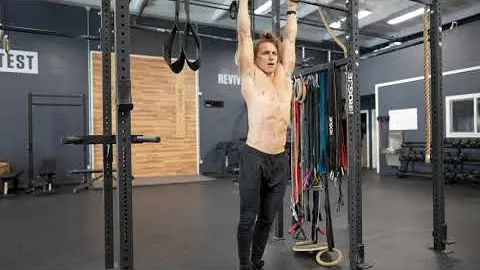
Are you tired of the same old core exercises and looking for a challenging workout that targets your obliques? Look no further than the Hanging Oblique Circle exercise. Not only does this exercise engage your core muscles, but it also helps improve stability and balance.
The Hanging Oblique Circle exercise is a challenging movement that requires a stable overhead bar. It primarily targets the oblique muscles, which are located on the sides of your abdomen. By using your bodyweight and performing circular motions, this exercise effectively engages and strengthens your core.
Start by hanging from an overhead bar: Grasp the bar with an overhand grip, with your arms fully extended. Make sure your body is in a straight line from head to toe.
Engage your core: Before you begin the circular motion, engage your core by squeezing your abdominal muscles. This will help stabilize your body throughout the exercise.
Initiate the circular motion: Begin the exercise by pulling your legs up toward your chest, bending at the hips and knees. As you reach the top of the movement, shift your body to the side and continue the circular path. Imagine tracing a large circle with your knees.
Maintain control: As you continue the circular motion, focus on maintaining control and stability. Avoid swinging or using momentum to complete the movement. The slower and more controlled you perform this exercise, the more effective it will be.
Switch directions: After completing a set number of repetitions in one direction, switch to the opposite direction. This will ensure both sides of your obliques are equally targeted and strengthened.
Gradually increase difficulty: To make the exercise more challenging, you can gradually increase the size of the circle you are tracing with your legs. Additionally, you can add ankle weights or a dumbbell between your feet to further challenge your core muscles.
Stronger oblique muscles: The primary benefit of this exercise is the strengthening and toning of your oblique muscles. This can lead to improved athletic performance and overall core stability.
Improved stability and balance: The Hanging Oblique Circle exercise requires significant core engagement, which helps improve stability and balance. By strengthening your core, you'll have better control over your body movements.
Engagement of other muscle groups: In addition to targeting your obliques, this exercise also engages your upper body and lower body muscles. Your arms, shoulders, and back work to support your bodyweight, while your legs are actively involved in the circular motion.
Variety in your workout routine: Adding the Hanging Oblique Circle exercise to your routine can provide variety and challenge to your core workout. It offers a refreshing change from traditional ab exercises and can help you break through plateaus.
While the Hanging Oblique Circle exercise is a beneficial core exercise, there are a few safety considerations to keep in mind:
Proper form: It's essential to maintain proper form while performing this exercise. Keep your body in a straight line and avoid hyperextending your lower back. If you feel any lower back pain or discomfort, stop the exercise and consult with a fitness professional.
Avoid swinging: To fully engage your core muscles, it's crucial to avoid swinging or using momentum to complete the movement. Focus on controlled and deliberate motions throughout the exercise.
Build strength gradually: If you're new to this exercise, start with smaller circles and gradually increase the difficulty as your strength improves. Listen to your body and don't push yourself beyond your limits.
The Hanging Oblique Circle exercise is an effective way to strengthen and tone your core, specifically targeting your oblique muscles. By incorporating this exercise into your routine, you'll not only improve your core strength but also enhance stability and balance. Remember to prioritize proper form and gradually increase the difficulty level. Spice up your workout routine with this challenging exercise and reap the benefits of a stronger, more stable core.
If you're looking for a gym, fitness club or yoga studio, you've come to the right place.
You can find information about gyms in your area. Browse catalog of gyms and find gyms with classes which are you looking for.
On gym page you can find simple information like address, phone or website. You can find list of available classes. You can check availability of personal training or small group classes. On place page you can also see information about open hours.
You can find gyms near you with amenities, courts, studios and equipments.
Use our map to find gym at your city or district.
In Gym Navigator you can find list of exercises with movies for many body parts.
You can browse exercises catalog and find exercises the best of you.
You can also find exercises grouped into workout plans, which you can use to improve you body. Each routine show you exercises one by one and give you possibility to count you progress and count down rest time.